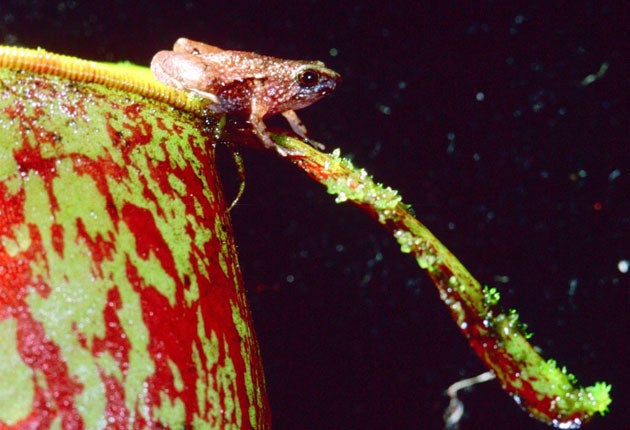Pea-sized frogs found in Borneo carnivorous plants

One of the world's tiniest frogs — barely larger than a pea — has been found living in and around carnivorous plants on Borneo island, one of the scientists who made the accidental discovery said today.
Indraneil Das, a scientist at University Malaysia Sarawak, said he and another scientist from Germany were doing field research on frogs in Malaysia's Sarawak state on Borneo island when they chanced on the tiny species on the edge of a road leading to the summit of a mountain in the Kubah National Park in 2006.
"For biologists, this is a curiosity," Das told The Associated Press.
The frogs were named Microhyla nepenthicola after the pitcher plant species where they live, Das said. A Malaysian museum had listed the species but misidentified it as juveniles of another frog species, he said.
The tubular plants are carnivorous, killing insects such as ants, but do not harm the frogs. Tadpoles grow in the liquid inside the plants.
Adult males of the amphibians range in size between 0.42 inches (10.6 millimeters) to 0.5 inches (12.8 millimeters), Das said.
The findings were published by Das and Alexander Haas of the Biozentrum Grindel und Zoologisches Museum of Hamburg, Germany in peer-review journal Zootaxa last week after they completed their research on the frogs.
Das said because the frogs were so small, he and his colleague only found them by tracking their singing of "harsh rasping notes" at dusk. They caught them by making them jump on a white cloth near the pitcher plants.
He added that the discovery should encourage efforts to protect the biological diversity in Borneo's rain forests.
Das said the tiniest known frog found was in Cuba, with its size of at least 0.39 inches (9.8 millimeters).
Join our commenting forum
Join thought-provoking conversations, follow other Independent readers and see their replies
Comments
Bookmark popover
Removed from bookmarks